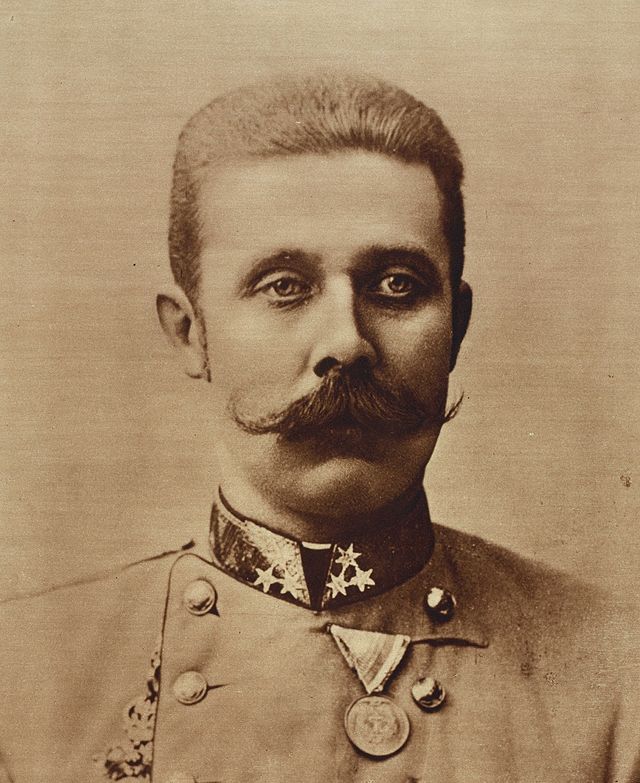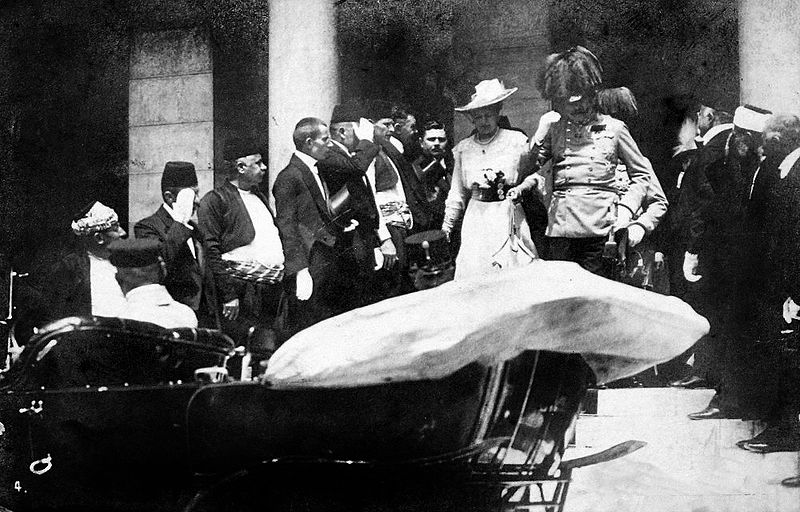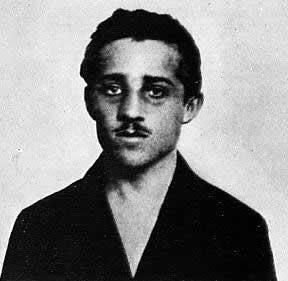The assassination of Archduke Franz Ferdinand of Austria on June 28th 1914 will forever be remembered as one of the key turning points in twentieth century world history. Archduke Franz Ferdinand, heir to the Austro-Hungarian throne, and his wife Sophie were shot dead in Sarajevo by Gavrilo Princip, a member of the Black Hand gang, a group of Serbian nationalists, whose aim was to free Serbia of the rule of the Austro-Hungarian empire. The assassination of its heir presumptive gave Austria-Hungary the opportunity to settle some old scores and declare war on Serbia, which, in turn, precipitated a political crisis between the major European powers, and this, in turn, triggered a chain of events which led directly to the outbreak of the First World War. This feature will commemorate the 100th anniversary of the Sarajevo assassination and explore how the event and its consequences are represented in the UL’s German collections.

Archduke Franz Ferdinand of Austria (source)
From an early age, Franz Ferdinand pursued a military career in the Austro-Hungarian army and became heir to the Habsburg throne following the suicide of his cousin Crown Prince Rudolf at the famous hunting lodge in Mayerling in 1889. There was tension in his relationship with Emperor Franz Joseph, but historians have differed regarding the nature of Franz Ferdinand’s political views. Some historians emphasise his liberalism compared to the emperor, especially his advocacy of greater autonomy for ethnic groups within the Austro-Hungarian empire, whilst others emphasise his Catholic conservatism and absolutist belief in Austro-Hungarian dynastic rule.
The biographical aspects of Franz Ferdinand’s life are explored in “Alma Hannig : Franz Ferdinand, die Biografie (2013)” at 607:4.c.201.6 and “Max Polatschek : Franz Ferdinand, Europas verlorene Hoffnung (1989)” at 607:45.c.95.39. The UL will be acquiring the latest three volume work on Franz Ferdinand’s life: “Wladimir Aichelburg : Erzherzog Franz Ferdinand von Österreich-Este 1863-1914 : Notizen zu einem ungewöhnlichen Tagebuch eines aussergewöhnlichen Lebens : Europas Weg zur Apokalypse (2014)”. There is also currently an exhibition of Franz Ferdinand’s travels entitled “Franz is here” at the Weltmuseum in Vienna and the UL will shortly be acquiring the catalogue of this exhibition.

Sarajevo Town Hall, a few minutes before the assassination (source)
On the morning of Sunday June 28th 1914, Archduke Franz Ferdinand and his wife visited Sarajevo to inspect the Austro-Hungarian army. Sarajevo was not considered to be hostile territory, so security was not tight, but in fact six assassins from the Serbian nationalist Black Hand organisation were waiting along the motorcade route, including Gavrilo Princip. The first conspirator failed to throw his bomb; the second failed to draw his pistol; and the third threw his bomb, but missed. The Archduke’s car sped away to the town hall and the remaining three conspirators all failed to act as the motorcade passed them at high speed. After speeches at the town hall, the Archduke changed his schedule in order to visit the wounded from the bombing in hospital. However, his chauffeur took a wrong turning, stopped the car and reversed. Gavrilo Princip was sitting at a café across the street. He seized his opportunity, walked across the street and shot both Franz Ferdinand and his wife at point blank range. They died shortly afterwards.

The arrest of Gavrilo Princip (source)
The full story of the assassination has recently been examined in “Gerd Krumeich : Juli 1914, eine Bilanz : mit einem Anhang : 50 Schlüsseldokumente zum Kriegsausbruch (2014)” at C208.c.3056. Some facsimiles of Princip’s manuscripts, including his signature, can be found in German translation in “Ein geschichtlicher Beitrag zur Vorgeschichte des Attentates von Sarajevo : Gavrilo Princips Bekenntnisse : zwei Manuskripte Princips, Aufzeichnungen seines Gefängnispsychiaters Dr. Pappenheim aus Gesprächen von Feber bis Juni 1916 über das Attentat, Princips Leben und seine politischen und sozialen Anschauungen (1926)” at 537.c.92.440 and documents from the Sarajevo trial can be found in “Friedrich Wurthle : Dokumente zum Sarajevoprozess : ein Quellenbericht (1978)” at P607.b.1.9. The UL will also be acquiring a recent re-appraisal of the Sarajevo assassination: “Gregor Mayer : Verschwörung in Sarajevo : Triumph und Tod des Attentäters Gavrilo Princip (2014)”.
The consequences of Franz Ferdinand’s assassination and its role in the origins of the First World War have long been debated by historians. The origins of the war are comprehensively examined by German historians in “Gerhard Hirschfeld & Gerd Krumeich : Deutschland im Ersten Weltkrieg (2013)” at C208.c.1826 and Markus Pohlmann, Harald Potempa & Thomas Vogel (eds.) : Der Erste Weltkrieg 1914-1918 : im Auftrag des Zentrums fur Militärgeschichte und Sozialwissenschaften der Bundeswehr (2014)” at C201.b.5354. A recent English re-appraisal of Germany’s role in the causes of the war has been written by Cambridge academic Christopher Clark in “Christopher Clark : The sleepwalkers : how Europe went to war in 1914 (2012)” at 537.c.201.408. Clark argues that to blame Germany for World War One is too simplistic and that all the statesmen of Europe were effectively sleepwalking into war. This book has become a bestseller in Germany. A more contemporary and propagandist German explanation of the war, first published in 1929, can be found in “Walter Jost & Friedrich Felger (eds.) : Was wir vom Weltkrieg nicht wissen (1938)” at CCC.25.249. And the most recent comprehensive German overview of the First World War can be found in “Jörn Leonhard : Die Büchse der Pandora : Geschichte des Ersten Weltkriegs (2014)” at 537.c.201.27.

Gavrilo Princip (source)
The consequences of the First World War for Austria-Hungary are less open to debate. Emperor Franz Joseph died in 1916 and two years later, after Austria’s defeat, the Austro-Hungarian monarchy was dissolved forever. The Austrian Republic and Hungarian Kingdom were created along with the new nation states of Czechoslovakia and Yugoslavia. An exhibition titled “An Meine Völker! Der Erste Weltkrieg 1914-1918” is currently being held in the Prunksaal der Österreichischen Nationalbibliothek, Vienna and the UL will shortly be acquiring the catalogue of this exhibition commemorating the last years of the Austro-Hungarian empire. A contemporary account of pre-war Austro-Hungarian politics can be found in “Richard Charmatz : Österreichs äussere und innere Politik von 1895 bis 1914 (1918)” at 9605.d.12 and “Ludwig Bittner (ed.) : Österreich-Ungarns Aussenpolitik von der bosnischen Krise 1908 bis zum Kriegsausbruch 1914 : diplomatische Aktenstücke des österreichisch-ungarischen Ministeriums des Äusseren (1930)” at 607:01.b.1.18-26. More recent studies of pre-1914 Austro-Hungarian politics can be found in “Holger Afflerbach : Der Dreibund : europäische Grossmacht- und Allianzpolitik vor dem Ersten Weltkrieg (2002)” at 607:01.b.1.84 and “Manfred Reinschedl : Die Aufrüstung der Habsburgmonarchie von 1880 bis 1914 im internationalen Vergleich (2001)” at C200.d.3882. The role of Austria in the First World War is examined in “Hans Magenschab : Der Grosse Krieg : Österreich im Ersten Weltkrieg 1914-1918 (2013)” at C201.b.5115 and a pictorial record can be found in “Wolfgang Maderthaner : Untergang einer Welt : der Grosse Krieg 1914-1918 in Photographien und Texten (2014)” at S950.a.201.2182. And finally, the downfall of the Habsburg monarchy and the subsequent disintegration of the Austro-Hungarian empire are comprehensively covered by “Manfred Rauchensteiner : Erste Weltkrieg und das Ende der Habsburgmonarchie 1914-1918 (2013)” at 539.c.201.561 and “Andreas Gottsmann (ed.) : Karl I (IV), der Erste Weltkrieg und das Ende der Donaumonarchie (2007)” at 911:01.b.30.16.
As for Gavrilo Princip, he attempted to take his own life, first with a cyanide capsule and then with his pistol. He failed. At 19, he was too young to be given the death penalty and so he was sentenced to the maximum sentence of 20 years in prison. He died of tuberculosis on April 28th 1918, age 23, at Terezin Fortress, 3 years and 10 months after his assassination of Archduke Franz Ferdinand had led to one of the greatest catastrophes of the twentieth century.
L. Noble
